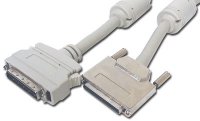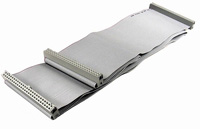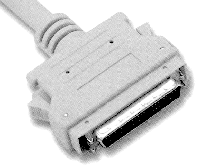 |
What is this SCSI anyway??SCSI, pronounced "scuzzy", is an acronym for Small Computer Systems Interface. It refers to a parallel hardware interface that allows for the connection of up to 15 peripheral devices to a single SCSI host adapter. |
The SCSI standard was developed as a result of suggestions by Alan Shugart who founded Seagate, with an ANSI technical committee working on the new standard as early as 1982. Apple was one of the first companies to use the new interface for their Macintosh computers after the official standard was released four years later in 1986. SCIS can be found in many other types of hardware, particularly servers and other enterprise level products, and is commonly used for attaching devices such as disk drives, backup systems, scanners and even specialised printers.
SCSI interfaces provide for faster data transmission rates than standard serial and parallel ports at up to 640 megabits per second. Because you can attach many devices to a single SCSI port, so that SCSI is really an I/O (In/Out) bus rather than just an interface.
SCSI is an ANSI standard, approved in 1986, but there are many variations of it so two SCSI interfaces may be incompatible with each other. These incompatibilities can be physical, because SCSI supports several types of connectors, or due to sytem and llength issues. Although not all devices support all levels of SCSI, the evolving SCSI standards are generally backwards-compatible. That is, if you attach an older device to a newer computer with support for a later standard, the older device will work at the older and slower data rate.
If you are looking for information on recognising the various SCSI connectors, please see our Recognising SCSI Connectors page which has full descriptions and images of the various types.
SCSI I, II, III, LVD and V
SCSI I (SCSI-1)
SCSI I was initially known simply as SCSI, but the -1 nomenclature was added to avoid confusion when later iterations of the standard were released. Now obsolete and deprecated this standard supported data rates of up to 5 Mbps over an eight bit bus, and supported only single ended signalling and passive terminators.
SCSI-1 devices typically used the Centronics 50 connector for external devices, whilst internal cables used a 50 pin ribbon cable with standard IDC connections.
It should be noted that connecting a SCSI-1 device to an LVD SCSI bus can cause serious performance issues with transfer speeds seriously degraded. If you should need to mix SCSI-1 devices with LVD you should connect each to its own bus or even better to its own interface card for optimum performance.
Leads Direct offers a wide range of cables and adapters to allow SCSI-1 devices to be connected to later SCSI buses in the SCSI section of our online shop.
SCSI II (SCSI 2)
Formally released in 1994 the SCSI-2 standard dramatically extended the capability of the SCSI bus. By adding Wide SCSI capability up to 16 devices could be connected to a single bus doubling the capacity of the original standard, and the addition of Fast SCSI doubled to spped of the bus to 10Mhz.
SCSI-2 also introduced active termination, differential signalling to allow longer cables, command queuing, and additional commands to support additional devices such as removeable media devices like CD-ROM drives, Scanners, and so on.
The SCSI 2 external cables use a high density 50 pin D shaped connector which uses a pair of 'squeeze' buttons connected to a latch used to secure and release the cable from the inlet, although many music related devices such as midi workstations used a 25 pin D type connector instead.
Leads Direct offers a wide range of cables and adapters to allow SCSI-2 devices to be connected to both earlier and later SCSI buses in the SCSI section of our online shop.
SCSI III (SCSI 3)
SCSI-3 is more of a group of specifications than a single standard, and as a result saying that something is 'SCSI 3' does not necessarily guarantee successful interconnection with other devices which could be using a different interface or command set.
The parts of the standard broadly fall into three categories: Commands, Protocols and Interconnects. A detailed examination of the standard would be very extensive and is beyone the scope of this article. However, if you need detailed information you can find details of standards organisations and how to contact them in the Standards Section of this technical library, and go directly to the relevant websites from our Standards Links page.
SCSI-3 external connections are made using a 68 pin D type connector with thumbscrew retention at the inlet. Internal connections use a 68 pin ribbon cable, but the exact cable required depends on the exact version being used.
Leads Direct offers a wide range of cables and adapters to allow SCSI-3 devices to be connected to both earlier and later SCSI buses in the SCSI section of our online shop. However, as described earlier, because of the wide range of differing specifications within the standard whilst we can easily provide the correct cables and connectors it is not possible for us to guarantee proper operation between devices - you should satisfy yourself that the devices are compatible before purchasing as if they are incompatible no amount of cable changing can solve that incompatibility!
LVD
LVD SCSI is a subset of the SCSI-3 standard, and is sometimes referred to as 'SCSI 4'. Ultra2 SCSI is another term commonly used to identify this particular type of SCSI.
LVD can offer transfer rates of up to 80 MBytes per second, differential data integrity, and cable lengths of up to 25 metres across the bus although the workable distances may well be less when using multiple devices.
The main connector for external cables is a 68 pin D type like the one used for SCSI-3. Internal ribbon cables again use 68 pin IDC connectors on a special ribbon cable.
You can connect older devices with earlier SCSI specifications to an LVD bus, but all the devices will effectively scale back to the earliest specification common to all devices. In some cases this could mean a significant loss of performance from some devices.
As you would proably expect by now, Leads Direct offers a wide range of cables and adapters to allow LVD devices to be connected to both earlier and later SCSI buses, and earlier and later devices to be connected to an LVD bus, in the SCSI section of our online shop.
SCSI V (SCSI 5)
SCSI 5 can implement faster speeds than earlier specifications (up to 640 MB/sec).
It uses the VHDCI (Very High Definition Centronics Interface) connector externally and is backwards compatible with earlier devices as far back as SCSI-2. Note that it is NOT compatible with SCSI 1 devices.
Leads Direct offers a wide range of cables and adapters to allow SCSI-5 devices to be connected to earlier SCSI buses, and earlier devices to be connected to a SVSI-5 bus, in the SCSI section of our online shop.
SCSI Implementations
At the time of writing he following varieties of SCSI are currently implemented:
| Technology Name |
Maximum Cable Length (meters) |
Clock Speed | Maximum Speed (MBps) |
Maximum Number of Devices |
| SCSI-1 | 6 | 5Mhz | 5 | 8 |
| SCSI-2 | 6 | 10Mhz | 5-10 | 8 or 16 |
| Fast SCSI-2 | 3 | 10Mhz | 10-20 | 8 |
| Wide SCSI-2 | 3 | 10Mhz | 20 | 16 |
| Fast Wide SCSI-2 | 3 | 10Mhz | 20 | 16 |
| Ultra SCSI-3, 8-bit | 1.5 | 20Mhz | 20 | 8 |
| Ultra SCSI-3, 16-bit | 1.5 | 20Mhz | 40 | 16 |
| Ultra-2 SCSI | 12 | 40Mhz | 40 | 8 |
| Wide Ultra-2 SCSI | 12 | 40Mhz | 80 | 16 |
| Ultra-3 (Ultra160/m) SCSI | 12 | 40Mhz | 160 | 16 |
| Ultra-320 SCSI | 12 | 80Mhz DDR | 320 | 16 |
| Ultra-640 SCSI | 12 | 160Mhz DDR | 640 | 16 |
SCSI Cabling
Leads Direct has a huge range of SCSI cables always in stock, and can offer technical advice prior to purchase. To browse the range please visit our e-Shop and review the SCSI Cables product category.
 |
Internal SCSI cables are usually ribbon cables that have multiple 68 pin or 50 pin connectors. Common configurations range from two connectors (device and host) up to 8 connectors (host plus 6 devices and terminator) or even more... To browse the range available visit the Internal SCSI Cable section of our e-Shop. |
External SCIS cables are round, shielded, and only have two connectors i.e. one on each end. There are many different connectors, and many combinations of connector used to connect disparate devices. To browse the range available visit the External SCSI Cable section of our e-Shop. |
 |
SCSI Connectors
For more detailed information about SCSI Connectors please see our SCSI Connectors page